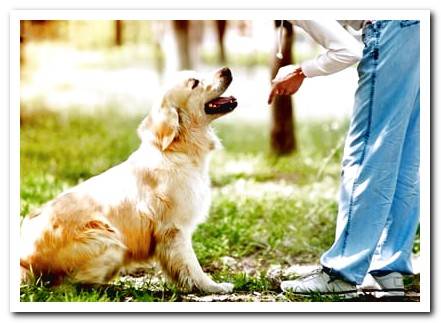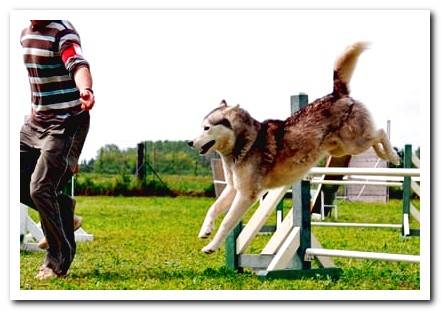
One of the most important steps when starting with the education of our dog is precisely being able to correctly convey our intentions. Tell him when he is doing it right and of course, know how to correct a dog when he is doing it wrong.
There are many different dog training / education techniques, they are all equally good and functional. But there are only a few correct techniques to indicate to our dog that we do not like his behavior or simply give him a touch of attention. We will review and explain how we should say “no” to our dog.
Index of contents
- 1 How to correct a dog: When should we correct it?
- 2 How to correct a dog: The “touch” or “bite”
- 3 How to Correct a Dog: The Educator / Trainer
- 4 How to correct a dog: My dog does not react, ignores me
- 5 How to correct a dog: My dog is a puppy
- 6 How to Correct a Dog: Other Alternatives
How to correct a dog: When should we correct it?
The most important thing when it comes to educating an adult dog or puppy is the common sense of whoever educates it. It is useless to dedicate a thousand hours to the training of our adult dog or puppy, if we do not do it the right way. And precisely one of the most common mistakes is to correct or scold our dog when it is not appropriate.
If what we want to scold our dog for something he did wrong, we must do it just when he is doing it, neither before nor after. For example, some people when they get home and see that their dog has broken something or done something wrong, scold or even hit him (something that should never be done), thus making a huge mistake.
Dogs are not fortune tellers and do not have the ability to relate what they have done in the recent past to the present. Therefore, if we want to correct our dog or give it a touch, we must do it right at the moment when it is breaking something or is behaving badly.
It is useless to do it later, at hours, or when we get home and see that there are broken things … Because dogs don’t relate that the anger you are giving him, is for having broken something previously. And yes, we all know that when we scold them they put that “sorry, it will not happen again” face, but in reality they have no idea why the scolding.
Whether we want to scold, just give a little attention or just correct, we must always, if or if, at the right time.

Let’s imagine that we are walking down the street in the company of our dog and we come across another person who is also walking with his dog. Our dog, who is obviously tied on his leash, suddenly makes a sharp turn and throws himself at the other dog, barking and growling, as if he wanted to bite him….
The correct thing to do in this situation is to correct our dog with a tug on the leash (slight but precise) while we scold him orally with a “No” or “SHhhh”. If he does not calm down and does not obey the correction, we will also give him a “bite” with the hand while we correct him orally. If he continues without obeying, we will sit him down and wait a while for him to calm down.
The wrong thing in this situation, something that obviously we should never do, is to get nervous, grumpy, constantly pulling on the lead of our dog and screaming like crazy “very bad” “that is not done” “no no no no no no” etc … .. This is precisely the most common and at the same time, the most erroneous.
How to correct a dog: My dog does not react, ignores me
If our dog does not react to the leash pull or the bite, we will simply repeat the act one or two more times until it obeys. If you still do not obey, we will order you to sit or lie down and wait for a few minutes in that state.
Dogs sometimes get stuck, get too upset, or just don’t focus, it is at that moment when we must make him sit down and relax since an altered dog cannot learn.
We should never, under any circumstances, hit our dog because it ignores us. Hitting a dog only creates fear and fear of doing something that involves a new attack. This causes great behavioral problems in the long run and can make the dog aggressive, therefore, a dog should never be punished with physical means (hitting, hitting, etc …).
If our dog does not react to our training sessions, does not react to touches or bites, it ignores us even if we have tried several times…. It may be a good time to go to a professional dog trainer. Find a good professional trainer, demand that they show you their degree to verify it, and follow their advice.

How to correct a dog: My dog is a puppy
The techniques that we have seen previously, mainly the “bite” with the hand accompanied by a “No!”, Are the ones that we should use with our puppy, but with a lot of common sense.
A puppy is just that, a puppy and therefore has no ability to react or execute our orders. Just think about playing, running, sleeping, playing and surely biting everything … it’s completely normal They are simply discovering the world around them.
A puppy does not need education until it is at least 6 months old, from there we can start, gradually and very patiently, to educate them. Although it is very important that we start socialize it with other dogs and humans. Remember, with a lot of patience and without losing the papers.
If our puppy bites us on the hand or does something wrong, we can scold him with “the bite” and “no!” together. Obviously, after scolding him, we cannot pamper him and play with him, we will wait a few minutes before playing with him or continuing with what we are doing.
You can see more info about puppy education here: Tips for training a puppy
How to Correct a Dog: Other Alternatives
There are many ways to educate / train a dog and they are all equally respectable. We offer information on some of these techniques, which we use and know to offer good results, but this does not necessarily mean that they are the best.
A professional dog trainer can help you a lot with the education of your dog or puppy, they are not a heavy investment (they are usually inexpensive) and they are very helpful.
A canine ethologist can help you solve strange behaviors, it
is like a “psychologist” for humans, only this time for dogs. Many times, by detecting the original problem, misbehavior can be solved, this is where canine ethologists work.
